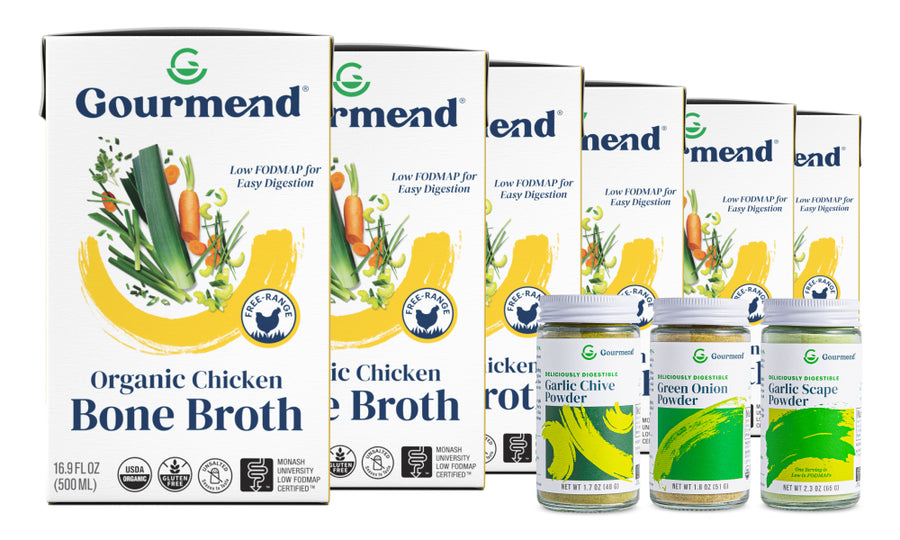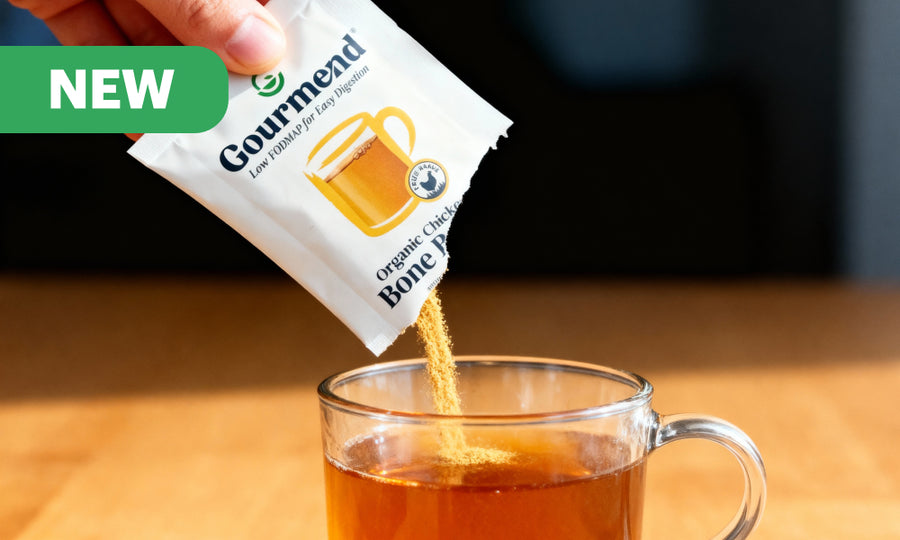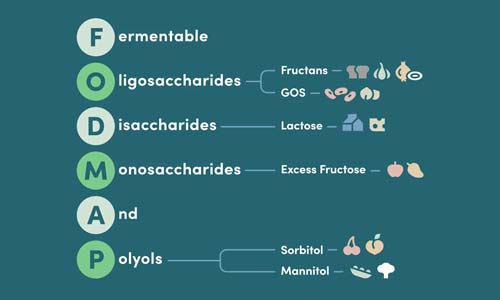Is Bacon Low FODMAP? The Complete Guide for 2025

If you're following a low FODMAP diet to manage IBS or digestive sensitivities, you've probably wondered: is bacon low FODMAP? It's a fair question—bacon appears in countless breakfast dishes, salads, and comfort foods, but navigating processed meats on a gut-friendly diet can feel tricky.
Key Takeaways
- Bacon is a common ingredient in many meals, making its FODMAP content an important consideration for those on a low FODMAP diet.
- People managing IBS or digestive sensitivities often question whether bacon is suitable for their diet.
- Processed meats like bacon can be challenging to navigate when following a gut-friendly eating plan.
Table of Contents
The good news? Most plain bacon can absolutely fit into your low FODMAP lifestyle. But like many processed foods, the devil is in the details—specifically, what's been added during processing.
At Gourmend Foods, we understand how frustrating it can be to second-guess every ingredient when you're working to heal your gut. That's why we've created this comprehensive guide to help you enjoy bacon confidently while supporting your digestive wellness.
Quick Answer
Yes, plain bacon is low FODMAP. Unprocessed, salt-cured bacon contains only protein and fat—no carbohydrates that could trigger digestive symptoms. However, flavored or seasoned bacon may contain high FODMAP additives like garlic powder, onion powder, or celery juice. Always check ingredient labels and choose plain, minimally processed options for the safest low FODMAP choice.
What Are FODMAPs?
Before we dive into bacon specifically, let's establish the foundation. FODMAPs are fermentable carbohydrates that can trigger digestive symptoms in sensitive individuals. The acronym stands for Fermentable Oligosaccharides, Disaccharides, Monosaccharides, and Polyols—essentially, short-chain carbs that your small intestine struggles to absorb.
When these compounds reach your large intestine undigested, gut bacteria ferment them rapidly, producing gas and drawing water into your bowel. For people with IBS or sensitive digestion, this process can cause bloating, cramping, diarrhea, or constipation.
Key insight: FODMAPs are carbohydrates. Foods that contain primarily protein and fat—like plain bacon—naturally contain little to no FODMAP content.
The Low FODMAP Diet Explained
The low FODMAP diet is a three-phase approach developed by researchers at Monash University to help people identify and manage their digestive triggers. Here's how it works:
- Elimination Phase (2-6 weeks): Remove high FODMAP foods to allow your gut to settle
- Reintroduction Phase (6-10 weeks): Systematically test individual FODMAP groups to identify your personal triggers
- Personalization Phase (ongoing): Create your customized long-term eating plan based on your tolerance levels
This evidence-based approach helps up to 75% of IBS sufferers find significant symptom relief. The key is understanding that it's not meant to be restrictive forever—it's a diagnostic tool to help you eat with confidence.
What is Bacon?
Understanding bacon's composition is crucial for determining its FODMAP status. Bacon is salt-cured pork, typically cut from pork belly, that undergoes a preservation process designed to enhance flavor and extend shelf life.
The Production Process
Traditional bacon production involves curing pork with salt and often nitrates or nitrites for preservation, safety, and that characteristic pink color. The curing process draws out moisture while infusing the meat with flavor—creating the bacon we know and love.
From a nutritional standpoint, plain bacon consists primarily of:
- Protein: About 3 grams per slice
- Fat: Approximately 3-4 grams per slice
- Carbohydrates: Less than 1 gram per slice
- Sodium: Roughly 185mg per slice
This composition is exactly why plain bacon fits well into a low FODMAP framework—it's essentially protein and fat with minimal carbohydrate content.
Pros
- Naturally low in carbohydrates
- High in protein and satisfying fats
- Adds rich, savory flavor to dishes
- Widely available and affordable
Cons
- High sodium content
- Processed meat with potential health concerns
- High fat content may trigger IBS symptoms in some people
- Flavored varieties often contain high FODMAP additives
Types of Bacon
Not all bacon is created equal. Here's what you'll find in the grocery store:
- Regular Pork Bacon
- Traditional salt-cured pork belly, available in thick-cut or regular varieties
- Turkey Bacon
- Lower-fat alternative made from turkey meat, often with similar curing processes
- Flavored Bacon
- Bacon with added seasonings like maple, peppered, or herb varieties—these require careful label reading
- Uncured Bacon
- Processed without synthetic nitrates/nitrites, often using celery juice as a natural preservative
Each type presents different considerations for low FODMAP eating, which we'll explore in detail throughout this guide.
Is Bacon Low FODMAP?
The straightforward answer is yes—but with important caveats. Let's break down exactly what makes bacon low FODMAP and when you need to exercise caution.
Plain Bacon: The Low FODMAP Winner
Plain, unprocessed bacon that's simply salt-cured pork contains virtually no carbohydrates, making it naturally low FODMAP. According to Monash University's official testing—the gold standard for FODMAP research—up to 500 grams of plain bacon tests as low FODMAP.
Scientific backing: Bacon's primary components are protein (about 25%) and fat (about 40%), with less than 1% carbohydrates. Since FODMAPs are fermentable carbohydrates, plain bacon simply doesn't contain the compounds that trigger digestive symptoms.
This makes bacon particularly appealing for those following a low FODMAP diet. You can enjoy it without worrying about portion restrictions that apply to many other foods during the elimination phase.
The Hidden FODMAP Triggers
Here's where things get tricky. Many commercial bacon products contain additives that can sabotage your low FODMAP efforts. The most common culprits include:
- Garlic powder: Often added for savory depth
- Onion powder: Used to enhance umami flavors
- Celery juice or powder: Common in "uncured" varieties as a natural preservative
- Natural flavorings: Vague term that may conceal high FODMAP ingredients
- Honey or maple syrup: Added to flavored varieties
These additives transform low FODMAP bacon into a potential trigger food. Even small amounts of garlic or onion powder can cause symptoms in sensitive individuals.
Label-reading tip: If the ingredient list contains more than salt, pork, and perhaps nitrates/nitrites, proceed with caution. The simpler the ingredient list, the safer it is for your low FODMAP diet.
Turkey Bacon and FODMAP Considerations
Turkey bacon hasn't been extensively tested by Monash University, but it's likely low FODMAP due to its similar nutritional profile. Like pork bacon, turkey bacon consists primarily of protein and fat with minimal carbohydrates.
However, turkey bacon often contains more additives than traditional pork bacon, including:
- Binding agents to hold the reformed meat together
- Flavor enhancers to mimic pork bacon's taste
- Preservatives for extended shelf life
Apply the same scrutiny to turkey bacon labels that you would to any processed meat product.
Portion Size and Practical Considerations
While Monash testing shows bacon is low FODMAP up to 500 grams, this doesn't mean you should eat over a pound of bacon daily. From a digestive health perspective, moderation remains key for several reasons:
| Consideration | Impact on Digestion | Recommended Approach |
|---|---|---|
| High Fat Content | May slow gastric emptying and trigger IBS symptoms | Limit to 2-3 slices per serving |
| Sodium Levels | Can cause bloating and water retention | Balance with low-sodium foods |
| Processed Meat Status | May affect gut microbiome diversity | Enjoy occasionally, not daily |
Remember, the low FODMAP diet aims to identify your personal triggers while maintaining nutritional balance. Even low FODMAP foods should fit into an overall healthy eating pattern.
How to Choose Low FODMAP Bacon
Selecting the right bacon for your low FODMAP diet requires becoming a savvy label reader. Here's your step-by-step guide to navigating the bacon aisle with confidence.
Step-by-Step Label Reading Guide
- Check the ingredient list first: Look for pork, salt, and perhaps sodium nitrite or sodium nitrate. These are your safe ingredients.
- Scan for high FODMAP red flags: Avoid products containing garlic powder, onion powder, celery juice, or "natural flavors."
- Verify gluten-free claims: If you're also managing celiac disease or gluten sensitivity, look for certified gluten-free labels.
- Consider the curing method: "Uncured" bacon often uses celery juice, which can be high FODMAP—stick with traditionally cured options.
- Assess the brand reputation: Established brands often have more consistent ingredient sourcing and clearer labeling.
Best Bacon Choices
- Plain, salt-cured pork bacon
- Thick-cut varieties (often less processed)
- Products with 3-4 ingredients maximum
- Brands that clearly list all ingredients
Bacon to Avoid
- Flavored varieties (maple, peppered, herb)
- Products with "natural flavoring"
- Bacon with garlic or onion powder
- Heavily processed or reformed products
Smart Shopping Strategies
Beyond label reading, these strategies will help you consistently find low FODMAP bacon options:
- Shop the perimeter first
- Fresh bacon from the butcher counter often has fewer additives than pre-packaged varieties
- Build relationships with butchers
- Local butchers can often tell you exactly what goes into their curing process
- Stock up when you find winners
- Bacon freezes well, so buy extra when you discover a reliable low FODMAP brand
- Consider online specialty retailers
- Some companies specialize in clean-label, minimally processed bacon products
At Gourmend Foods, we understand how time-consuming this detective work can be. That's why we've developed our line of low FODMAP broths and seasonings—to give you the rich, savory flavors you crave without the guesswork. Our products use chive sprigs and green leek tops to deliver that satisfying depth typically achieved with garlic and onion.
Pro tip: When in doubt, choose the bacon with the shortest, simplest ingredient list. The fewer additives, the less likely you are to encounter hidden FODMAP triggers.
Remember, finding the right bacon for your low FODMAP diet may take some trial and error. Start with small portions of new products and pay attention to how your body responds. This mindful approach will help you build a reliable roster of go-to bacon options that support both your taste preferences and digestive wellness.
Low FODMAP Bacon Alternatives and Substitutes
While plain bacon can fit into a low FODMAP diet, some people prefer alternatives due to dietary restrictions, health considerations, or simply wanting variety. Here are proven substitutes that deliver similar smoky, savory satisfaction without compromising your digestive wellness.
Plant-Based Alternatives
- Coconut bacon (unsweetened flakes with smoked paprika)
- Tempeh strips marinated in low FODMAP seasonings
- Shiitake mushroom "bacon" with tamari and maple syrup
- Eggplant bacon seasoned with smoked salt
Protein-Rich Options
- Smoked chicken or turkey strips
- Duck prosciutto (check for additives)
- Smoked salmon pieces
- Pancetta (Italian unsmoked bacon, often cleaner ingredients)
Creating Bacon Flavor Without Bacon
Sometimes you want that distinctive smoky, salty taste without the actual meat. Here's how to achieve bacon-like flavor using low FODMAP ingredients:
- Smoked paprika and sea salt
- Combines smokiness with the essential saltiness that defines bacon's appeal
- Liquid smoke (check ingredients)
- Adds authentic smokehouse flavor to vegetables, tofu, or other proteins
- Nutritional yeast
- Provides umami depth that mimics bacon's savory complexity
- Tamari or soy sauce
- Delivers the salty, fermented notes that make bacon so satisfying
At Gourmend Foods, we've mastered the art of building complex, satisfying flavors without high FODMAP ingredients. Our broths incorporate chive sprigs and green leek tops to create that savory depth typically achieved with garlic and onion, while our beef broth includes nori seaweed and oyster mushrooms for natural umami richness.
Recipe success tip: When substituting bacon in recipes, consider both flavor and texture. Crispy elements like toasted nuts or seeds can provide the textural contrast that makes bacon so appealing in dishes.
For more inspiration on delicious, gut-friendly meals, check out our low FODMAP recipes collection.
Cooking and Storage Tips for Low FODMAP Bacon

Proper preparation and storage techniques can maximize both the flavor and digestive benefits of your low FODMAP bacon choices.
Optimal Cooking Methods
- Start with room temperature bacon: Remove from refrigerator 15-20 minutes before cooking for even heat distribution
- Use medium heat: High heat can create tough, chewy bacon and may produce compounds that irritate sensitive digestive systems
- Drain excess fat: Pat cooked bacon with paper towels to remove excess grease that could trigger IBS symptoms
- Cool before adding to salads: Hot bacon can wilt greens and create an unpleasant texture contrast
- Store rendered fat separately: Bacon fat can be saved for cooking other low FODMAP foods, adding flavor without additional triggers
Storage Best Practices
Proper storage extends shelf life while maintaining food safety—crucial considerations for anyone managing digestive sensitivities:
| Storage Method | Duration | Best Practices |
|---|---|---|
| Refrigerator (raw) | 7-10 days | Keep in original packaging or airtight container |
| Freezer (raw) | 3-6 months | Wrap tightly in freezer paper or vacuum seal |
| Refrigerator (cooked) | 3-5 days | Store in airtight containers, separate layers with parchment |
| Freezer (cooked) | 2-3 months | Flash freeze on baking sheets, then transfer to freezer bags |
Food safety reminder: People with IBS often have heightened sensitivity to foodborne pathogens. Always follow proper food handling procedures and trust your instincts about food freshness.
For a deeper dive into the science and expert opinions on this topic, see this detailed article on is bacon low FODMAP.
Making Informed Bacon Choices for Your Low FODMAP Journey
The relationship between bacon and the low FODMAP diet is refreshingly straightforward: plain, simply-cured bacon fits perfectly into your eating plan, while heavily processed varieties require careful scrutiny. This clarity empowers you to make confident choices that support both your digestive wellness and your enjoyment of food.
Remember that successful low FODMAP eating isn't about restriction—it's about informed selection. When you understand which bacon products work for your body and which ingredients to avoid, you can savor that crispy, smoky satisfaction without digestive consequences.
Final takeaway: The key to enjoying bacon on a low FODMAP diet lies in choosing products with simple, transparent ingredient lists and consuming them as part of a balanced, varied eating plan.
As you continue exploring low FODMAP options, consider how quality ingredients and thoughtful preparation can transform your relationship with food. At Gourmend Foods, we're committed to helping you discover that eating for digestive wellness doesn't mean sacrificing the bold, satisfying flavors that make meals memorable.
Whether you're enjoying a weekend breakfast with perfectly crispy bacon or exploring plant-based alternatives that deliver similar satisfaction, the most important ingredient is knowledge. Armed with the insights from this guide, you can navigate the bacon aisle—and your low FODMAP journey—with confidence and enthusiasm.
Check out our Low Fodmap Bundles





